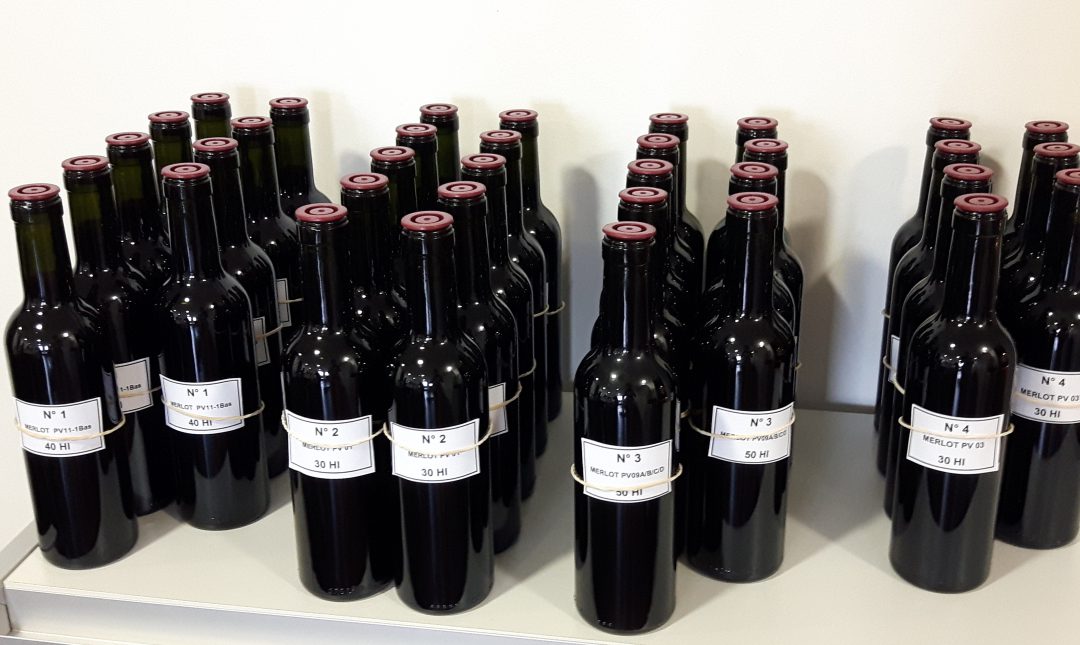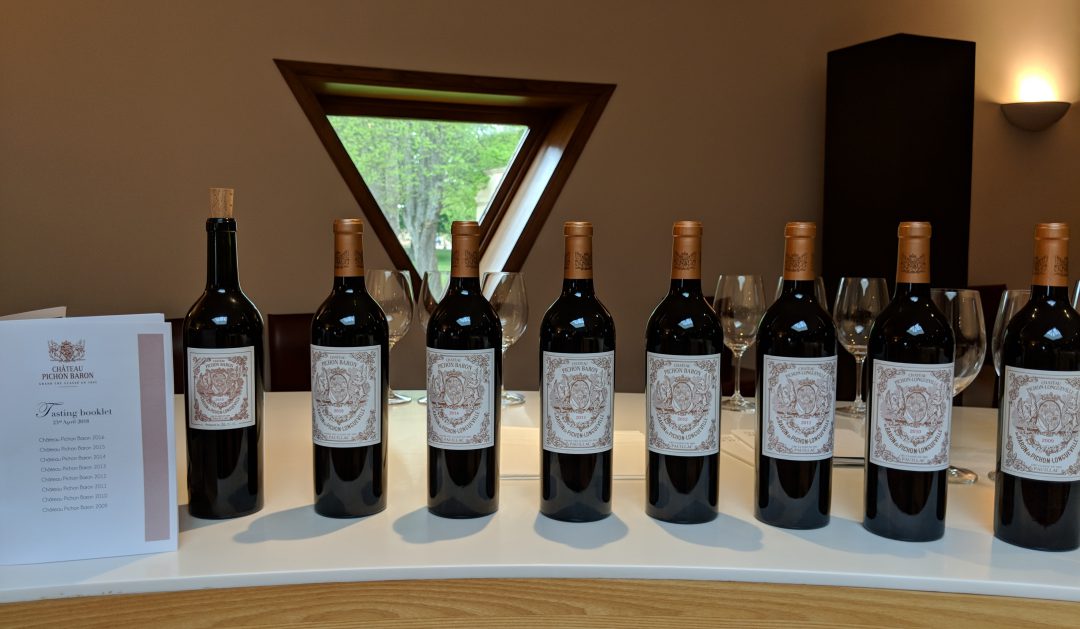After a fabulous dinner in the gracious company of Christian Seely, managing director of AXA Millésimes, and Corinne Ilic, AXA Communications Director, we headed to bed with visions of 2005 vintage Château Pichon Baron dancing in our heads.
In our rooms, a document awaited us. The next morning, we were set to visit another AXA property: Château Petit-Village in Pomerol. The document contained instructions, starting with the day’s objective, namely “to create a blend from 7 samples of pure individual grape varieties from the 2017 vintage”.
Many people equate Bordeaux to Cabernet Sauvignon. However, Cabernet is only one of six grape varieties permitted for Bordeaux reds. These wines, barring a few exceptions, are always blends of two or more grapes. Moreover, Cabernet Sauvignon is not the most widely planted red grape in Bordeaux. That honour goes to Merlot.
Bordeaux reds, barring a few exceptions, are always blends of two or more grapes.
The most acclaimed vineyards of Bordeaux are divided into those on the left bank of a large body of water, the Gironde Estuary (and its tributary, the Garonne), and those on the right bank of another tributary, the Dorgogne river. On the left bank, Cabernet Sauvignon is the principal grape in the majority of fine wine blends. On the right bank, Merlot reigns supreme, with Cabernet Franc as its blending partner.
Perhaps you are wondering why Bordeaux wine producers blend multiple grapes together in their wines? Why not focus on individual varietals as they do in Burgundy and elsewhere?
There are many reasons. Two of the most important are related to climate and soil conditions.
Each grape type has its own specificities. If you were to plant different varieties of roses in your garden, you would see that each would bud and bloom at different dates; each would be more or less resistant to drought, to heavy rain, and to all manners of pests and diseases. Vineyards are the same.
On the left bank, Cabernet Sauvignon is the principal grape in the majority of fine wine blends. On the right bank, Merlot reigns supreme.
The left bank of Bordeaux has a temperate maritime climate with hot summers and mild autumns. The famous vineyards of the Médoc area are protected from cooling Atlantic breezes by coastal pine forests. This is the ideal climate for the late ripening Cabernet Sauvignon. On the right bank, significantly further inland from the coast, the climate is continental with cooler winters and chilling winds. Cabernet Sauvignon struggles to reach maturity here, but Merlot, an earlier ripening variety, thrives, as does Cabernet Franc.
Soil types vary widely from one vineyard to another in Bordeaux. Gravelly soils (in temperate areas) work well for Cabernet Sauvignon. They drain water away well, and radiate heat back up to the vines, providing a warmer environment to boost ripening. Clay soils are cooler, retaining water, and absorbing heat. Merlot is better suited to clay. Cabernet Franc can adapt to a wide variety of soils, yielding lighter, fresher wines in sand or limestone rich soils, and bolder, fuller-bodied wines in clay soils.
To ensure that each piece of land is used optimally growers plot out these soil and micro-climatic variations and plant different grapes accordingly.
The majority of Bordeaux vineyards have a wealth of different soil types. And while the left bank is generally warmer than the right bank, there are many factors that affect the micro-climate of each individual vineyard (orientation, altitude, shelter or lack thereof from wind, just to name a few). To ensure that each piece of land is used optimally – growing grapes that have the best chance of remaining healthy and reaching full ripeness year after year – growers plot out these soil and micro-climatic variations and plant different grapes accordingly.
Co-planting provides wine producers with an insurance policy of sorts. If certain parcels attain only marginal ripeness, are ravaged by frosts, or hit hard by rot, higher percentages of healthier, riper grapes can be selected from other vineyard plots to create the season’s blend. While vintage variation is an accepted trait in Bordeaux (see article here), each Château still strives to maintain a sense of stylistic similarity from one year to the next. This forms their reputation, and brings them a loyal following from their patrons.
Crafting the vintage’s blend is arguably the most important of the winemaker’s yearly tasks. Fine winemakers ferment each grape and plot separately. The wines are then transferred to barrel to begin their élévage. This resting period in contact with the micro-porous wood allows the wine to soften and harmonize.
Crafting the vintage’s blend is arguably the most important of the winemaker’s yearly tasks.
Depending on the percentage of new barrels used, their origin, fabrication methods, and so forth, the oak will impart more or less flavouring components (such as cedar or vanilla notes) to the wine. During this maturation period, the winemaker will take samples from each lot and taste them with his team to determine how much, if any, of each parcel will make it into the Grand Vin. This lofty term refers to the top wine of the estate. Lots judged lesser in quality are downgraded to the second and sometimes third wines of the Château.
Blending is a veritable art. There are many factors that need to be taken into consideration. The winemaker must calculate the overall quantity of wine required and the volume available of each parcel. They must also consider how the wine will evolve in bottle. An age-worthy Bordeaux requires blending components with fresh acidity, firm structure, and good tannic grip. Tasted early on in their maturation, these elements may appear less seductive, but given time to soften they will form an attractive framework, enhancing the more expressively fruity, plusher lots.
Our blending session at Château Petit-Village was, in reality, nothing more than an amusing exercise. The winemakers knew better than to let us loose on their fine wine! Daniel Llose, AXA Millésimes Technical Director, very generously gave of his time to guide us in our endeavors. We tasted through seven different parcels: 5 Merlot base wines from different plots and of varying vine ages, 1 Cabernet Franc, and 1 Cabernet Sauvignon. We then split into two-man teams and got busy with our funnels, beakers, and pipettes, pouring varying amounts of each of our preferred samples into a bottle, thus creating our Pomerol blends.
Blending is a veritable art. The winemaker must consider how the wine will evolve in bottle.
Pomerol is a small, yet highly prestigious appellation on the right bank. There are just under 800 hectares of vines planted here on a mix of gravel, limestone and clay soils. Château Petit-Village has an enviable position at the highest point of the (low lying) Pomerol vineyards, where the soils are gravelly with optimal drainage. The subsoil here is of particular note. The highly prized “crasse de fer”, an iron-rich clay, is said to impart complex aroma of truffles to the resultant wines. Grapes grown on these soils are the most sought after of Pomerol.
After our blends were tasted and politely deemed acceptable by Daniel, we moved on to taste the finished product. Over a sumptuous lunch of roasted duck, we sampled three very fine vintages of Château Petit-Village: 2010, 2007, 2000.
Without further ado, my notes:
Château Petit-Village Pomerol 2010
Fragrant aromas of ultra-ripe dark plum, black cherry, and blueberry dominate the nose, underscored with licorice, truffle, cedar, and floral notes. Powerfully structured and weighty, with rounded acidity. Velvety in texture, with impressive depth of dark fruit flavours lingering long on the persistent, layered finish. Firm, fine-grained tannins ensure superior ageability.
Blend: 73% Merlot, 18% Cabernet Franc, 9% Cabernet Sauvignon
Ageing: 70% new French oak, 30% second use barrels. 15 months.
Château Petit-Village Pomerol 2007
Pretty notes of crushed plum, ripe raspberry, and blueberry mingle with hints of violet and subtle oaked nuances. Quite fresh and vibrant in style, with a full-body, soft, chalky texture, and medium weight, powdery tannins. Not as concentrated as the 2010, but very elegant, with well-integrated oak, and a long, lifted finish.
Blend: 78% Merlot, 16% Cabernet Franc, 6% Cabernet Sauvignon
Ageing: 60% new French oak, 40% second use barrels. 15 months.
Château Petit-Village Pomerol 2000
Fully mature, with an attractive tertiary nose featuring earthy, truffle aromas, dried plum, sweet tobacco hints, and exotic spice. Still pleasingly fresh on the palate, with a full-body, and supple texture. A concentrated core of dried floral and savoury nuances marks the mid-palate. The tannins are plush and rounded.
Blend: 75% Merlot, 18% Cabernet Franc, 7% Cabernet Sauvignon
Ageing: 70% new French oak, 30% second use barrels. 15 months.


